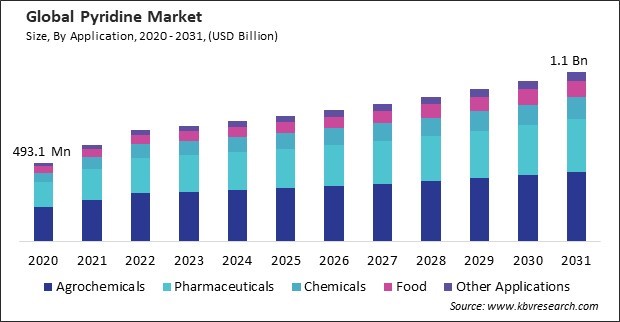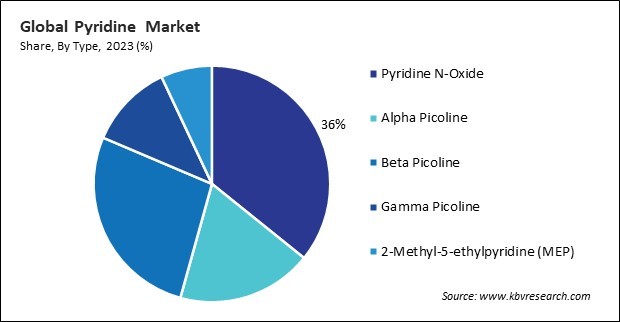“Global Pyridine Market to reach a market value of 1.1 Billion by 2031 growing at a CAGR of 5%”
The Global Pyridine Market size is expected to reach $1.1 billion by 2031, rising at a market growth of 5.0% CAGR during the forecast period. In the year 2023, the market attained a volume of 248,852.8 tonnes, experiencing a growth of 20.9% (2020-2023).
Beta picoline serves as a precursor in the synthesis of vitamin B3 (niacin) and its derivatives, which are indispensable in the pharmaceutical, food and beverage, and animal nutrition sectors, among others. Therefore, the beta picoline segment procured more than 1/4th revenue share in the market in 2023. In terms of volume, 113,848.5 tonnes of Beta picoline are expected to be utilized by 2031. Beta picoline, 3-methylpyridine, is a pyridine derivative with the chemical formula C6H7N. It is one of the three isomeric forms of methylpyridine, with alpha and gamma picoline being the other two isomers.

The growing demand for sustainable agriculture practices has led to the development of environmentally friendly pyridine-based agrochemicals. Manufacturers focus on creating formulations that minimise environmental impact while maintaining high efficacy. Certain pyridine derivatives, for instance, are engineered to degrade rapidly in the environment, thereby decreasing their persistence and bioaccumulation potential. Additionally, Preservatives are another critical application of pyridine in the food and beverage industry. With increasing consumer demand for longer shelf life and food safety, pyridine-based preservatives are used to prevent spoilage and contamination. This compound is widely used in acidic foods such as soft drinks, fruit juices, and pickles to extend their shelf life. Hence, Therefore, the expanding agriculture sector and the increasing use of pyridine derivatives in the food and beverage industry is driving growth of the market.
However, the potential risks associated with raw material price volatility may discourage prospective investors from venturing into the pyridine industry or expanding current ventures. The uncertainty surrounding future raw material costs can make investors hesitant to commit capital to pyridine production facilities, leading to a slowdown in market expansion and investment in the sector.
Based on type, the market is divided into pyridine N-oxide, alpha picoline, beta picoline, gamma picoline, and 2-methyl-5-ethylpyridine (MEP). The 2-methyl-5-ethylpyridine (MEP) segment acquired 7% revenue share in the market in 2023. In terms of volume, 19,731.5 tonnes of 2-methyl-5-ethylpyridine (MEP) pyridine are expected to be utilized by the year 2031. With the chemical formula C9H13N, MEP is a pyridine derivative and belongs to the alkylpyridine group. One of the key applications of MEP is producing flavours and fragrances. MEP is known for its strong, pleasant odour, making it a valuable ingredient in the formulation of fragrances for perfumes, cosmetics, and household products.

On the basis of application, the market is classified into agrochemicals, pharmaceuticals, chemicals, food, and others. The agrochemicals segment recorded 43% revenue share in the market in 2023. In terms of volume, 165,326.7 tonnes of Pyridine is expected to be utilized in agrochemical by the year 2031. Pyridine and its derivatives are widely used in the production of agrochemicals, including herbicides, pesticides, and insecticides, making them essential components of modern agriculture. The increasing global population has increased the demand for food and agricultural products. Farmers increasingly turn to agrochemicals to improve crop yields and protect against pests and diseases to meet this demand.
Free Valuable Insights: Global Pyridine Market size to reach USD 1.1 Billion by 2031
Region-wise, the market is analysed across North America, Europe, Asia Pacific, and LAMEA. The Asia Pacific segment garnered 48% revenue share in the market in 2023. In terms of volume, 124,771.5 tonnes of pyriding es expected to be utilized in this region by the year 2031. The expansion of industries, such as electronics, chemicals, and manufacturing in Asia Pacific, has contributed to the rising demand for pyridine. Pyridine produces various electronic components, speciality chemicals, and materials, making it an essential ingredient in these industries.
| Report Attribute | Details |
|---|---|
| Market size value in 2023 | USD 725.5 Million |
| Market size forecast in 2031 | USD 1.1 Billion |
| Base Year | 2023 |
| Historical Period | 2020 to 2022 |
| Forecast Period | 2024 to 2031 |
| Revenue Growth Rate | CAGR of 5.0% from 2024 to 2031 |
| Quantitative Data | Volume in Tonnes, Revenue in USD Billion, and CAGR from 2020 to 2031 |
| Number of Pages | 280 |
| Tables | 590 |
| Report coverage | Market Trends, Revenue Estimation and Forecast, Segmentation Analysis, Regional and Country Breakdown, Porter’s 5 Forces Analysis, Company Profiling, Companies Strategic Developments, SWOT Analysis, Winning Imperatives |
| Segments covered | Type, Application, Region |
| Country scope |
|
| Companies Included | Bayer AG, Lonza Group Ltd., Jubilant Pharmova Limited, Mitsubishi Chemical Holdings Corporation, Jarchem Innovative Industries LLC (Vertellus Holdings LLC), Imperial Chemical Corporation, Koei Chemical Co., Ltd., Shandong Luba Chemical Co., Ltd., Hebei Yanuo Chemical Industry Co., Ltd., Chang Chun Petrochemical Co., Ltd. |
By Type (Volume, Tonnes, USD Billion, 2020-2031)
By Application (Volume, Tonnes, USD Billion, 2020-2031)
By Geography (Volume, Tonnes, USD Billion, 2020-2031)
The Market size is projected to reach USD 1.1 billion by 2031.
Rising Demand in The Food and Beverage Industry are driving the Market in coming years, however, Fluctuation in the Cost of Raw Materials restraints the growth of the Market.
Bayer AG, Lonza Group Ltd., Jubilant Pharmova Limited, Mitsubishi Chemical Holdings Corporation, Jarchem Innovative Industries LLC (Vertellus Holdings LLC), Imperial Chemical Corporation, Koei Chemical Co., Ltd., Shandong Luba Chemical Co., Ltd., Hebei Yanuo Chemical Industry Co., Ltd., Chang Chun Petrochemical Co., Ltd.
In the year 2023, the market attained a volume of 248,852.8 tonnes, experiencing a growth of 20.9% (2020-2023).
The Pyridine N-Oxide segment is leading the Market by Type in 2023; thereby, achieving a market value of $359.3 million by 2031.
The Asia Pacific region dominated the Market by Region in 2023; thereby, achieving a market value of $512.3 million by 2031.
Our team of dedicated experts can provide you with attractive expansion opportunities for your business.

 Drivers
Drivers
 Restraints
Restraints
 Opportunities
Opportunities
 Challenges
Challenges
